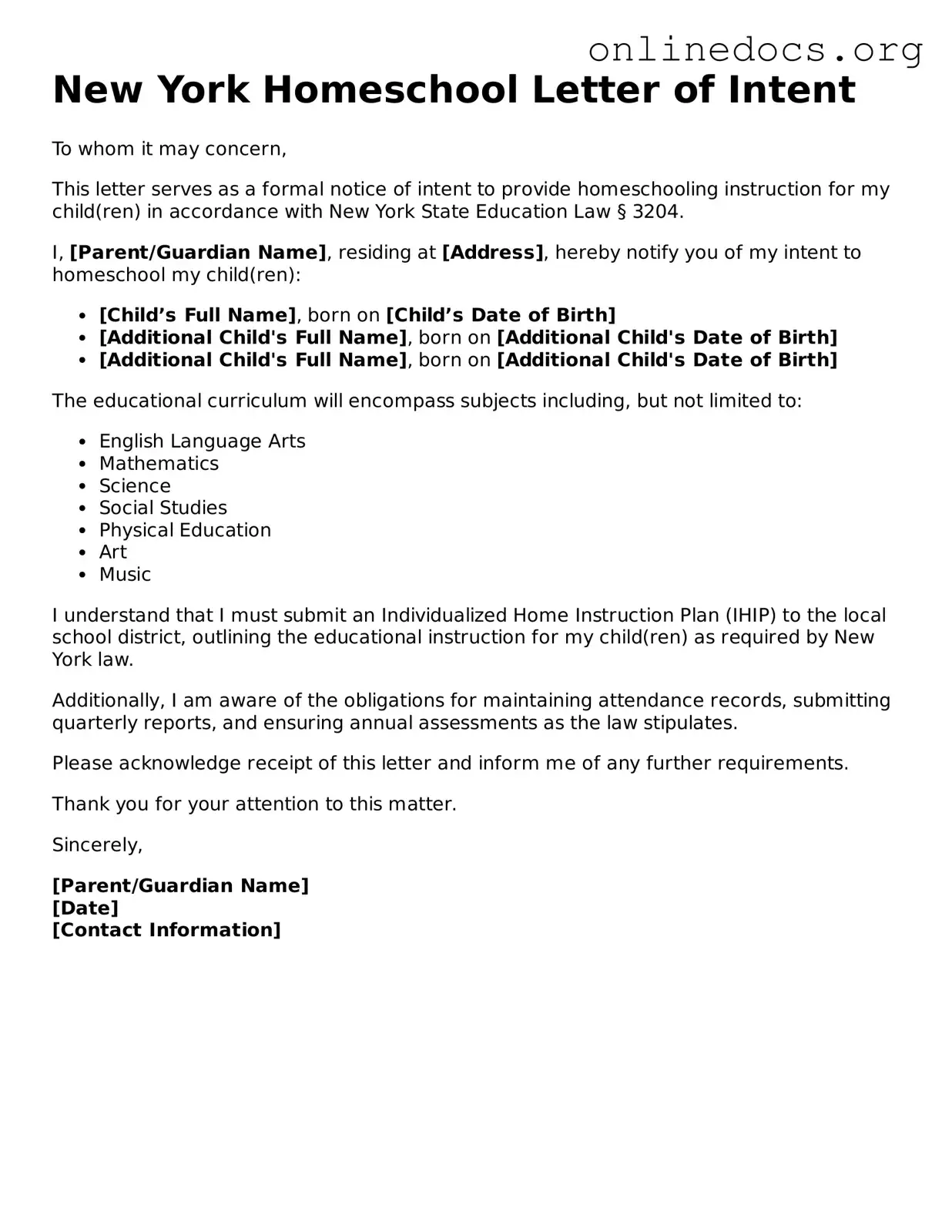The New York Homeschool Letter of Intent form is similar to the Notice of Intent form used in many states for families wishing to homeschool their children. This document serves as an official notification to the local school district that parents plan to educate their children at home. Just like the New York form, the Notice of Intent typically requires basic information about the child and the educational plan the parents intend to follow. The goal is to ensure that the school district is aware of the homeschooling arrangement and can provide any necessary oversight or resources.
Another comparable document is the Home Education Program Registration form, which some states require. This form often includes information about the curriculum, teaching methods, and the educational qualifications of the parents. Similar to the New York form, it establishes a formal relationship between the homeschooling family and the educational authorities, ensuring compliance with state regulations. Both documents aim to protect the educational rights of families while ensuring that children receive a quality education.
The Individualized Education Plan (IEP) is another document that shares similarities with the Homeschool Letter of Intent. While the IEP is specifically designed for children with disabilities, it outlines the educational goals and services tailored to the child's needs. Like the Letter of Intent, it requires detailed information about the child's educational progress and the strategies that will be employed. Both documents emphasize the importance of a structured educational approach, although the IEP is more focused on special education needs.
The Affidavit of Intent to Homeschool is a document used in some states that serves a similar purpose. This affidavit requires parents to declare their intent to homeschool their children formally. It often includes a statement of compliance with state laws regarding homeschooling. Like the New York form, it provides a clear declaration of the parents' commitment to educating their children outside of the traditional school system.
The Curriculum Plan document is another important piece that aligns with the Homeschool Letter of Intent. This plan details the educational materials and subjects the family will cover throughout the year. While the Letter of Intent notifies the school district of the family's homeschooling intent, the Curriculum Plan provides specifics on how the education will be delivered. Both documents are essential for demonstrating a commitment to a structured educational experience.
The Educational Assessment Report is also similar in purpose. This document outlines the methods of evaluating a child's progress in a homeschooling environment. It provides a summary of the child's achievements and areas needing improvement. Like the Homeschool Letter of Intent, it ensures accountability in the educational process and demonstrates the parents' commitment to their child's learning outcomes.
The Withdrawal Form from Public School is another relevant document. This form is used when parents decide to remove their child from a public school to begin homeschooling. It typically requires the parents to indicate their reasons for withdrawal and may need to be submitted to the school district. Similar to the Letter of Intent, it serves as a formal notification to the educational authorities regarding the change in the child's educational status.
The Statement of Educational Philosophy is a document some states require from homeschooling families. This statement outlines the parents' beliefs and approaches to education. It often includes details about the educational values they wish to impart to their children. Like the Homeschool Letter of Intent, it provides insight into the family's educational approach and helps establish a framework for learning.
The California Power of Attorney form is a crucial document that empowers individuals to make informed decisions on behalf of another, particularly when the latter is unable to do so. Similar to the various documents required for homeschooling, this form ensures clarity and intent in managing important responsibilities. For those interested in understanding the process further, consider visiting https://californiapdfforms.com/power-of-attorney-form/ to access the necessary resources and templates.
Lastly, the Annual Progress Report is a document that many states require to ensure that homeschooled children are making adequate progress. This report typically summarizes the child's educational achievements over the year and may include standardized test results or other assessments. It serves a similar purpose to the Homeschool Letter of Intent by ensuring ongoing communication between the family and educational authorities, reinforcing the commitment to a quality education.
